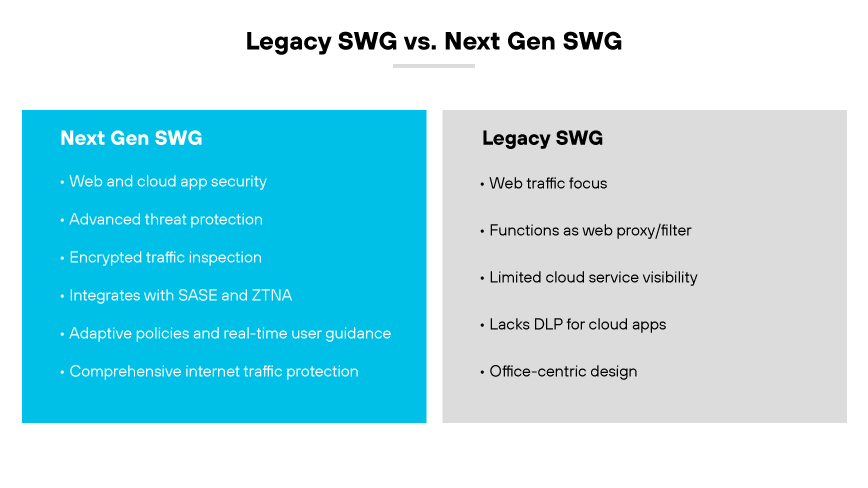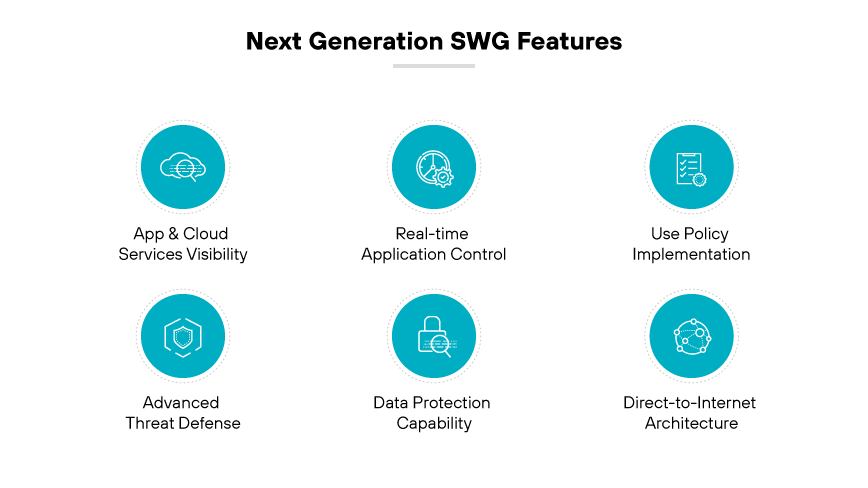-
What Is a Secure Web Gateway (SWG)? | A Comprehensive Guide
- How does a secure web gateway work?
- Why are secure web gateways necessary for network security?
- What are the benefits of secure web gateways?
- What are the features of secure web gateways?
- What are the most common secure web gateway deployment challenges?
- How do secure web gateways enforce acceptable use policies?
- How do secure web gateways secure remote workforces and branch offices?
- What is the role of secure web gateways in SASE?
- How do secure web gateways relate to compliance?
- Comparing secure web gateways with other security technologies
- What is the history of secure web gateways?
- How are secure web gateways evolving for the future?
- How to choose the right secure web gateway for your business
- Secure web gateways FAQs
- What Is a Cloud Secure Web Gateway?
- Secure Web Gateway vs. CASB: What Is the Difference?
- Secure Web Gateway vs. Firewall: What Is the Difference?
- What Are Secure Web Gateway Use Cases?
-
Secure Web Gateway vs. Proxy Server: What Is the Difference?
- What Is an SWG?
- What Is a Proxy Server?
- Is a Proxy and Secure Web Gateway the Same?
- What Are the Differences Between SWGs and Proxy Servers?
- What Are the Similarities Between SWGs and Proxy Servers?
- How to Choose Between SWG vs. Proxy Server
- The Roles of SWGs and Proxy Servers in SASE
- SWG vs. Proxy Server FAQs
- SASE and Secure Web Gateway: How Are They Related?
- Secure Web Gateway vs. WAF: What Is the Difference?
What Is a Next-Generation Secure Web Gateway (SWG)?
A next-generation secure web gateway (SWG) is a cloud-based security solution that safeguards organizations from advanced online threats and data risks.
Next-generation SWGs operate beyond traditional web traffic, protecting organizations from modern cloud threats and data security challenges. This technology is the new iteration of its legacy predecessor, offering enhanced visibility and control over both application content and user interactions. A next-gen SWG facilitates direct internet access for users and devices, regardless of location, without the need for traffic rerouting to centralized security appliances.
What Is the Difference Between a Legacy SWG and a Next-Gen SWG?

A legacy secure web gateway (SWG) functions primarily as a web proxy or web filter, designed to manage and secure only web traffic. The concept emerged when most organizational traffic was web based, and work occurred in a physical office. Traditional SWGs often lack the ability to decode and inspect app and cloud service traffic, leaving them blind to many cloud-delivered threats. They generally do not provide data loss prevention (DLP) for cloud applications, which is a critical component in today's digital landscape.
A next-generation SWG is a cloud-native solution that provides comprehensive security for both web and cloud app traffic. This modern approach to cybersecurity is necessary for effective protection because cloud services, and the growing number of remote workers who access them, are increasing. Next-gen SWGs offer advanced threat protection, including encrypted traffic inspection, and can manage the use of both known unknown (shadow IT) cloud applications.
The next-gen secure web gateway integrates seamlessly with security service edge (SSE)/secure access service edge (SASE) architectures. This consolidates multiple security services into a single cloud-based platform. The integration allows for the inspection and control of several types of user traffic, beyond the traditional web traffic. SASE also supports the shift to Zero Trust network access (ZTNA), which does not automatically trust any entity based on location or network. This ensures protection for any user or device, regardless of location, with minimal performance impact.
Next-gen secure web gateways combine traditional proxy capabilities with inline cloud access security brokers (CASB) and DLP platforms. This combination allows for more nuanced, granular controls over user activities in the cloud, allowing organizations to apply adaptive policies based on contextual data like app risk, user behavior, and data sensitivity. This way, they can provide real-time guidance to users, promoting safer practices without impeding work.
While traditional SWGs offer basic web filtering and security controls, next-gen SWGs represent an evolution in cybersecurity. They address the modern business’ needs by providing deeper control, better visibility, and more comprehensive protection across all avenues of internet traffic.
What Is a Secure Web Gateway (SWG)?
Next-Generation SWG Features

App and Cloud Services Visibility
A next-gen SWG provides clear visibility into both managed and unmanaged applications and cloud services, along with web traffic.
Real-Time Application Control
This feature allows for immediate and detailed regulation of cloud applications, giving organizations the ability to manage usage effectively.
Use Policy Implementation
Next-gen SWGs enable the incorporation of comprehensive use policies that cover both web and cloud environments, based on dynamic and traditional web filtering techniques.
Advanced Threat Defense
They offer sophisticated mechanisms to counteract web- and cloud-based threats, including machine learning-based anomaly detection and sandboxing technologies.
Data Protection Capability
Next-gen SWGs track and secure data across all platforms, employing methods from exact data matching to advanced fingerprinting for precise inspection.
Direct-to-Internet Architecture
These systems provide direct internet connectivity, preventing poor user experience for remote users and reducing the need for traffic rerouting through central data centers.
Comparing Next-Gen SWGs with Other Security Technologies
Next-Gen SWGs vs. Firewalls
Firewalls serve as a network's gatekeeper, monitoring and controlling incoming and outgoing traffic based on security rules. Unlike firewalls that primarily focus on permitting or denying traffic based on IP addresses and ports, next-gen SWGs provide a more nuanced security approach. They analyze traffic at the application level, looking at the content of the data packets to make security decisions. This allows next-gen SWGs to enforce more complex rules based on the actual transmitted data, rather than just packet headers.
Next-gen SWGs also differ from firewalls in their ability to decrypt and inspect SSL/TLS encrypted traffic, which enables them to identify and block sophisticated threats that hide in encrypted flows. Firewalls typically do not decrypt traffic, which can allow encrypted threats to pass through unnoticed. Additionally, next-gen SWGs can integrate with cloud access security brokers (CASBs) and data loss prevention (DLP) systems, providing comprehensive control over data in motion and at rest, something traditional firewalls are not designed to do.
Next-Gen SWGs vs. CASBs
Next-gen SWGs primarily secure web traffic, combining traditional web filtering with advanced threat protection and data loss prevention. They inspect web traffic to prevent exposure to cyberthreats and ensure compliance with corporate policies.
CASBs, in contrast, secure cloud applications and services. They provide visibility into shadow IT, enforce security policies across cloud environments, and manage data in cloud applications. CASBs extend security controls to cloud services that are beyond the direct control of the organization's internal IT infrastructure. They also ensure compliance with external regulations and corporate policies for data in the cloud, which is crucial for enterprises using multiple cloud services.
While next-gen SWGs focus on inline traffic management and threat prevention for both known and unknown web applications, CASBs emphasize the governance of cloud service usage, compliance assurance, and data security across sanctioned and unsanctioned cloud services.
Although they share some functional overlap, especially in providing visibility and data security, the two are complementary: next-gen SWGs offer robust web traffic management, and CASBs offer detailed control over cloud application usage.